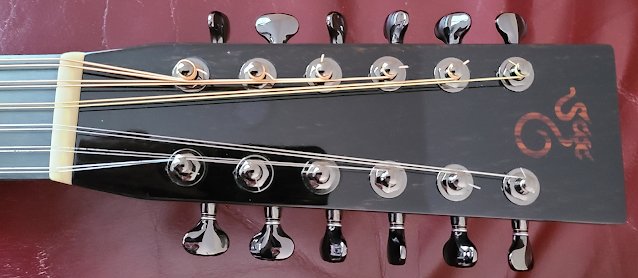Updating the Alto 12-string
As an artist endorser for Santa Cruz Guitars, I've asked them to build some slightly unusual instruments for me over the years. One of these is the 12-string Alto guitar, which they built for me in 2008. The Alto is based on the classic Martin 00 body and scale length. I've always liked the unique and unusual voicing in a Martin or Santa Cruz 00; it can be delicate, light, and airy, but simultaneously balanced and powerful in its own way. You can read more about the Alto-12 here.
 |
| Course spacing: before |
I took the Alto to my friend Laurent Brondel for some work and modifications in 2021. Laurent installed a custom stereo K&K pickup system, and performed a fret level.
Over the past few months, I've been shedding with it, and had almost forgotten what a special instrument it is. In my experience, maple guitars take much longer to open up than any other variety of back/sides tonewood. Of my two maple instruments, I'd say it's close to 10 years for a maple instrument to really open up. Since I last recorded with it, the Alto has further opened up, bringing more projection and power to its voice. I like this instrument more now than ever. It's also a great contrast, both in voice and in register, to the Contra guitars, Subcontras, and Baritone instruments.
 |
| Course spacing: after, and with new bridge pins |
Since the Alto was built, my preferences for course spacing have evolved. I like wider spacing between courses, and a tighter spacing within a course. Having more space between courses greatly helps with polyphonic playing techniques. To accomplish this usually requires a new nut with tighter spacing, modifying the bridge pins, and carving string guides in the saddle. Fortunately, the nut spacing on the Alto was just about perfect for my current preferences. However, the bridge pins were forcing such a wide course spacing that it almost appeared to have 12 single courses instead of six doubles.
Yesterday, I set out to do some work on the Alto:
- Nut buzz: The third string had developed a sitar-like sympathetic buzzing at the nut, likely due to some uneven nut wear over the years. I filled and re-cut that string slot, and eliminated the buzzing.
- Fingerboard oiling: I also applied a light rubbing of Watco Danish oil on the ebony fingerboard, as it had become a bit dry, as ebony tends to do.
- Bridge pins: I removed the original Santa Cruz slotted ebony bridge pins, and fitted a new set of Stewart-MacDonald unslotted ebony pins. I prefer unslotted pins; however, they require that the bridge is correctly slotted for each string; I made this modification to the Alto right after I received it. I love the Stewart-MacDonald unslotted pins; I have them in all the non-carbon fiber instruments. I use either bone or ebony, depending on the tone I want. Yes, bridge pin shapes and materials do impact tone. Fitting bridge pins is a long, slow, tedious process involving needle files. By carefully shaving the pin shaft with needle files, I can perfectly fit it to its corresponding bridge pin hole. For my double-course instruments, I've also developed a technique of shaving one side of the bridge pin's head to allow for a tighter course spacing. This is done for the front row (nearest the saddle) of pins. I use a caliper for measuring and uniformity, and remove the exact same amount from each pin.
- Bridge saddle: After fitting and modifying the new set of bridge pins, I installed a new set of strings. Then, using another type of needle file, I carved very slight string guides in the saddle. This allows for perfect, or perfect for me, course spacing.



Comments
Post a Comment